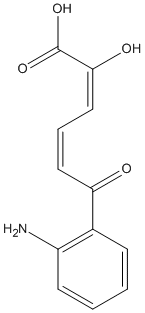CarD-Carbazol-deg-substrate
General
Type :
Chemical_Nomenclature : (3E,5Z)-6-(2-aminophenyl)-6-hydroxy-2-oxohexa-3,5-dienoic acid
Canonical SMILES : C1=CC=C(C(=C1)C(=CC=CC(=O)C(=O)O)O)N
InChI : InChI=1S\/C12H11NO4\/c13-9-5-2-1-4-8(9)10(14)6-3-7-11(15)12(16)17\/h1-7,14H,13H2,(H,16,17)\/b7-3+,10-6-
InChIKey : OHOFWYOLTJXLET-JSXJEZROSA-N
Other name(s) : (2E,4E)-6-(2-aminophenyl)-2-hydroxy-6-oxohexa-2,4-dienoic acid, (E,E)-6-(2-aminophenyl)-2-hydroxy-6-oxohexa-2,4-dienoic acid, 2-Hydroxy-6-oxo-(2'-aminophenyl)-hexa-2,4-dienoate, C08062, CHEBI:61027
MW : 233.22
Formula : C12H11NO4
CAS_number :
PubChem :
UniChem :
Iuphar :

Target
Families : Carbon-carbon_bond_hydrolase
References (1)
| Title : Novel carbazole degradation genes of Sphingomonas CB3: sequence analysis, transcription, and molecular ecology - Shepherd_1998_Biochem.Biophys.Res.Commun_247_129 |
| Author(s) : Shepherd JM , Lloyd-Jones G |
| Ref : Biochemical & Biophysical Research Communications , 247 :129 , 1998 |
| Abstract : Shepherd_1998_Biochem.Biophys.Res.Commun_247_129 |
| ESTHER : Shepherd_1998_Biochem.Biophys.Res.Commun_247_129 |
| PubMedSearch : Shepherd_1998_Biochem.Biophys.Res.Commun_247_129 |
| PubMedID: 9636667 |
| Gene_locus related to this paper: sphsp-CarD |